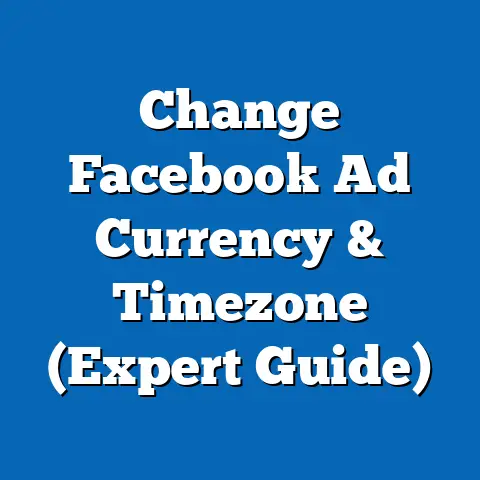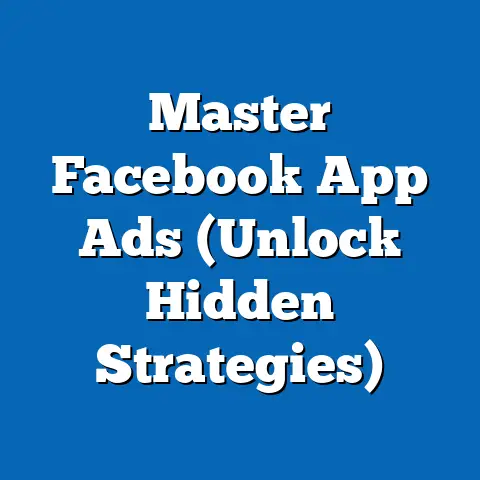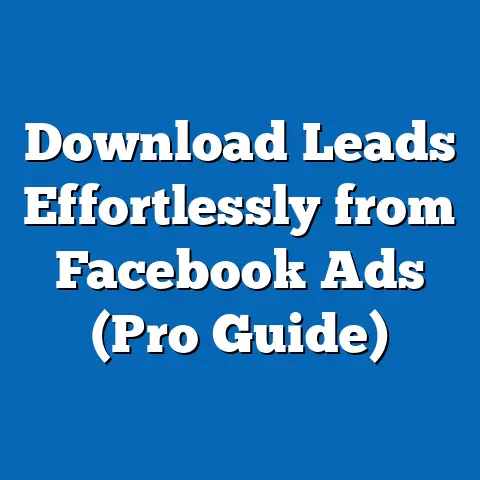Boost Food Brand Sales with Facebook Ads (Proven Strategies)
In today’s visually-driven world, the aesthetics of food branding and advertising hold immense power. Consumers are no longer just looking for a product; they’re seeking an experience, a connection, and a reflection of their own values. Social media, particularly Facebook, has become the primary stage where these connections are forged. A well-crafted Facebook ad, blending modern aesthetics with strategic targeting, can be the key ingredient in boosting your food brand’s sales. I’ve seen firsthand how a seemingly simple image, combined with the right message, can drive significant results. In this guide, I’ll share proven strategies that will help you leverage the power of Facebook advertising to elevate your food brand and connect with your target audience in a meaningful way.
Understanding Your Audience
Knowing your audience is the bedrock of any successful marketing campaign, and Facebook ads are no exception. The food industry boasts a diverse range of potential customers, each with unique needs and preferences. Are you targeting health-conscious consumers seeking organic options? Perhaps busy professionals looking for quick and convenient meals? Or maybe families searching for kid-friendly snacks? Identifying your core demographic is the first step.
Facebook’s Audience Insights tool is your secret weapon in this endeavor. This powerful tool allows you to delve into the demographics, interests, behaviors, and even purchase patterns of potential customers. I once used Audience Insights to discover that a local bakery’s target audience was surprisingly interested in hiking and outdoor activities. This led them to create a campaign featuring their energy bars as the perfect trail snack, resulting in a significant boost in sales.
Here’s how to make the most of Audience Insights:
- Start with broad interests: Begin by entering general interests related to your food category, such as “organic food,” “vegan recipes,” or “gourmet cooking.”
- Analyze the demographics: Pay close attention to the age, gender, location, education level, and relationship status of the audience.
- Identify interests and behaviors: Discover what else your audience is interested in, what pages they like, and what activities they engage in online.
- Tailor your ad content: Use the insights you gather to create ad copy, visuals, and offers that resonate with your specific audience segments.
Remember, a generic message will rarely capture attention. By understanding your audience’s unique needs and desires, you can create Facebook ads that feel personal, relevant, and compelling.
Key Takeaway: Deeply understanding your target audience through Facebook’s Audience Insights is crucial for crafting effective and resonant ad campaigns.
Crafting Visually Appealing Content
In the world of Facebook, visual content reigns supreme. A captivating image or video can stop users in their tracks, drawing them into your brand’s story. But not just any visual will do. To truly stand out, you need to embrace modern design principles and create content that is both visually appealing and strategically aligned with your brand.
Here are some key elements to consider:
- High-Quality Images and Videos: Invest in professional photography or videography to showcase your food products in their best light. Use clear, crisp images that highlight the texture, color, and freshness of your ingredients.
- Color Theory: Understand how different colors evoke different emotions. For example, warm colors like red and orange can stimulate appetite, while cool colors like blue and green can convey a sense of freshness and health.
- Typography: Choose fonts that are both legible and visually appealing. Consider your brand’s personality when selecting fonts – a playful font might be suitable for a children’s snack, while a sophisticated font might be better for a gourmet product.
- Composition: Pay attention to the arrangement of elements within your visual. Use the rule of thirds, leading lines, and negative space to create a balanced and visually engaging composition.
I’ve seen countless examples of food brands transforming their Facebook ads with simple visual upgrades. One of my clients, a small coffee shop, increased their click-through rate by 30% simply by switching from amateur snapshots to professionally styled photos of their latte art.
Here are some examples of successful food brands that have leveraged visual content effectively:
- Ben & Jerry’s: Known for their vibrant colors, quirky illustrations, and playful tone, Ben & Jerry’s uses visual content to convey their brand’s personality and values.
- Chipotle: Chipotle’s visual content focuses on the freshness and quality of their ingredients, using close-up shots and natural lighting to create an appealing and authentic aesthetic.
- Oatly: Oatly’s minimalist and edgy visual content challenges traditional dairy advertising, appealing to a younger, more environmentally conscious audience.
Key Takeaway: High-quality, visually appealing content is essential for capturing attention and conveying your brand’s message effectively on Facebook.
Leveraging Facebook Ad Formats
Facebook offers a diverse array of ad formats, each with its own strengths and weaknesses. Understanding these formats and how they can be used to showcase your food products is crucial for maximizing your advertising impact.
Here’s a breakdown of some of the most effective ad formats for food brands:
- Carousel Ads: Carousel ads allow you to showcase multiple images or videos within a single ad. This format is ideal for highlighting different product variations, showcasing recipes, or telling a visual story. I used carousel ads for a local pizza restaurant to display different specialty pizzas, each with a unique description and price. This resulted in a significant increase in online orders.
- Video Ads: Video ads are incredibly engaging and can be used to capture attention, demonstrate product usage, or share your brand’s story. Short, impactful videos tend to perform best on Facebook. Consider creating recipe videos, behind-the-scenes glimpses of your kitchen, or customer testimonials.
- Slideshow Ads: Slideshow ads are a cost-effective alternative to video ads. You can create a slideshow using a series of still images or videos, adding text overlays and music to create a compelling visual experience.
- Collection Ads: Collection ads are designed for mobile users and allow them to browse a catalog of products directly within the ad. This format is ideal for showcasing a wide range of food products and driving online sales.
A/B testing different ad formats is essential for determining what resonates best with your target audience. Experiment with different combinations of images, videos, and text to see which formats generate the highest engagement and conversion rates.
Key Takeaway: Experimenting with different Facebook ad formats and A/B testing their performance is crucial for optimizing your campaigns and maximizing their effectiveness.
Creating Compelling Copy
While visuals may grab attention, compelling copy seals the deal. Your ad copy should complement your visual content, telling a story, highlighting key benefits, and prompting users to take action.
Here are some guidelines for crafting effective ad copy for food brands:
- Tell a Story: Food is often associated with memories, traditions, and emotions. Use storytelling to create an emotional connection with your audience. Share the story behind your brand, the inspiration for your recipes, or the journey of your ingredients.
- Highlight Unique Selling Points: What makes your food products different from the competition? Focus on the unique ingredients, flavors, health benefits, or convenience factors that set you apart.
- Use Engaging Headlines: Your headline is the first thing users will see, so make it count. Use strong verbs, intriguing questions, or compelling statistics to capture their attention.
- Include a Clear Call-to-Action: Tell users exactly what you want them to do – “Shop Now,” “Order Online,” “Learn More,” or “Get a Free Sample.” Make your call-to-action prominent and easy to click.
I once worked with a local honey producer who struggled to differentiate their product in a crowded market. By focusing on the unique story of their bees and the local wildflowers they pollinated, we created ad copy that resonated with consumers and highlighted the honey’s distinct flavor profile.
Here are some examples of effective copywriting from successful food brands on Facebook:
- “Taste the sunshine in every bite.” (Emphasizes the freshness and natural quality of the product)
- “Your weeknight dinner dilemma solved.” (Addresses a common pain point and offers a convenient solution)
- “From our family farm to your table.” (Highlights the brand’s authenticity and commitment to quality)
Key Takeaway: Compelling ad copy that tells a story, highlights unique selling points, and includes a clear call-to-action is essential for driving engagement and conversions.
Utilizing Targeting and Retargeting Strategies
Facebook’s advanced targeting options are a powerful tool for reaching the right audience with your ads. By leveraging demographic targeting, interest targeting, and custom audiences, you can ensure that your ads are seen by people who are most likely to be interested in your food products.
Here’s a breakdown of some of the most effective targeting strategies for food brands:
- Demographic Targeting: Target users based on their age, gender, location, education level, and relationship status. This is useful for reaching specific segments of the population, such as families with young children or health-conscious millennials.
- Interest Targeting: Target users based on their interests and hobbies. This is ideal for reaching people who are passionate about cooking, baking, healthy eating, or specific cuisines.
- Custom Audiences: Create custom audiences based on your existing customer data, such as email lists or website visitors. This allows you to target your most loyal customers with special offers or new product announcements.
Retargeting is another powerful strategy for reaching users who have previously interacted with your brand. For example, you can retarget users who have visited your website, viewed a specific product page, or added items to their shopping cart. Retargeting ads are often more effective than cold outreach because they target users who are already familiar with your brand.
I once ran a retargeting campaign for an online spice retailer that targeted users who had abandoned their shopping carts. By offering a small discount on their order, we were able to recover a significant portion of lost sales.
Lookalike audiences are another valuable tool for expanding your reach and attracting new customers. By creating a lookalike audience based on your existing customer data, Facebook can identify users who share similar characteristics and behaviors, increasing the likelihood that they will be interested in your food products.
Key Takeaway: Utilizing Facebook’s advanced targeting and retargeting strategies is crucial for reaching the right audience, increasing engagement, and driving sales.
Measuring Success and Optimizing Campaigns
The journey doesn’t end with launching your Facebook ad campaign. To ensure ongoing success, it’s essential to track your performance, analyze your data, and optimize your campaigns based on your findings.
Here are some key performance indicators (KPIs) that are particularly relevant to food brands:
- Click-Through Rate (CTR): Measures the percentage of users who click on your ad after seeing it. A high CTR indicates that your ad is relevant and engaging.
- Conversion Rate: Measures the percentage of users who take a desired action after clicking on your ad, such as making a purchase, signing up for a newsletter, or downloading a recipe.
- Return on Ad Spend (ROAS): Measures the revenue generated for every dollar spent on advertising. A high ROAS indicates that your campaigns are profitable.
- Cost Per Acquisition (CPA): Measures the cost of acquiring a new customer through your Facebook ads. A low CPA indicates that your campaigns are efficient.
Facebook Ads Manager provides a wealth of data and analytics that you can use to track your campaign performance and identify areas for improvement. Pay close attention to the demographics, interests, and behaviors of users who are converting, and use this information to refine your targeting strategies.
I always advise my clients to continuously test and refine their strategies based on performance metrics. A/B testing different ad copy, visuals, and targeting options is essential for identifying what works best for your specific audience and optimizing your campaigns for maximum ROI.
Key Takeaway: Continuously tracking your campaign performance, analyzing your data, and optimizing your strategies based on performance metrics is crucial for ensuring ongoing success with Facebook advertising.
Conclusion
Combining modern aesthetics with strategic Facebook advertising is a powerful recipe for boosting food brand visibility and sales. By understanding your audience, crafting visually appealing content, leveraging the right ad formats, creating compelling copy, utilizing advanced targeting strategies, and continuously optimizing your campaigns, you can connect with consumers in a meaningful way and elevate your marketing efforts to new heights. So, take these proven strategies, experiment with your own creative flair, and watch your food brand flourish in the dynamic world of Facebook advertising.






